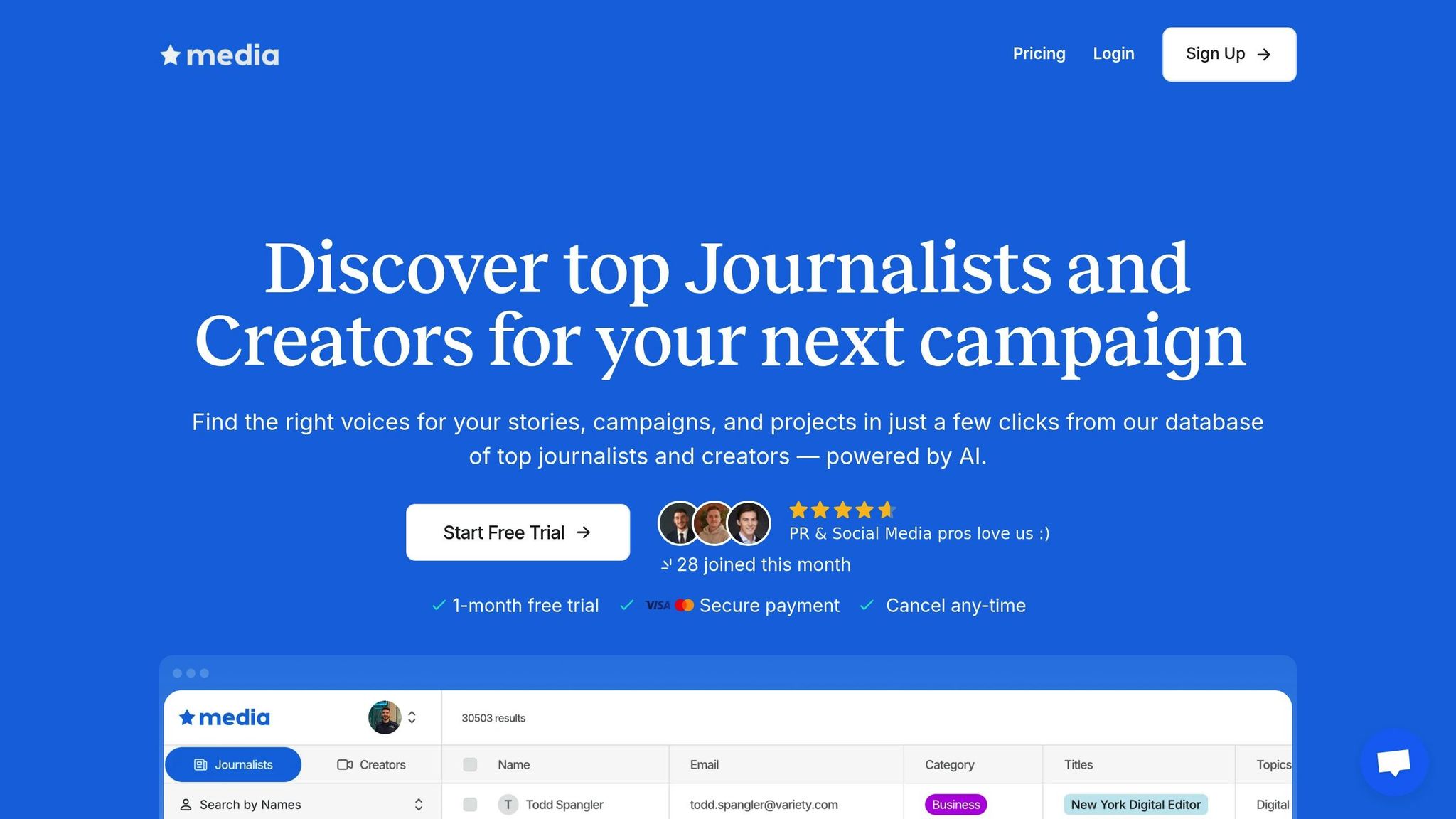Ultimate Guide to Journalist Outreach Strategy
Learn effective strategies for journalist outreach, including personalization, AI tools, and building lasting media relationships to boost visibility.

In today’s competitive media landscape, journalist outreach is essential for brands to gain trust and visibility. Unlike paid ads, media coverage acts as a third-party endorsement, helping businesses connect with wider audiences. But standing out in a journalist’s inbox - where they receive 100+ pitches daily - requires personalized, relevant, and well-timed messaging.
Here’s what you need to know:
- Personalization is key: 79% of journalists prefer pitches tailored to their specific beats or interests.
- AI tools save time: Platforms like Media AI reduce manual work by up to 40%, helping you find the right journalists and craft targeted pitches.
- Focus on relationships: Long-term connections with journalists lead to better results than one-off pitches.
- Avoid common mistakes: Generic, overly promotional, or irrelevant pitches are often ignored.
Media Relations Tips: How to Get Journalists to Actually Read Your Pitch
Journalist Outreach Basics
Journalist outreach is all about building meaningful relationships with media professionals to secure coverage and boost your brand’s visibility. To do this effectively, you need to understand who you’re reaching out to, what matters to them, and how your story aligns with their editorial goals.
Over the last ten years, traditional media has evolved to coexist with online platforms and influencer networks. While this shift introduces more opportunities, it also intensifies the competition for attention. Today, successful outreach relies on digital tools, authentic connections, and data-driven storytelling to create pitches that resonate with journalists and their audiences. The era of mass-sending generic press releases is long gone.
In 2025, 96% of journalists will use social media for work, with 59% favoring LinkedIn and 64% using it to share content. This trend means PR professionals must engage across multiple digital platforms to stay relevant.
AI-powered tools have also transformed the game, enabling hyper-targeted campaigns based on real-time data. For example, 73% of PR professionals already use AI tools, and 72% of companies plan to adopt them by 2025. Platforms like Media AI provide access to a database of over 30,000 journalists and creators, with advanced filtering options. These tools can cut the time spent on drafting and editing press releases by up to 60% while boosting placement rates by as much as 30%.
However, as Molly Bell from Interdependence reminds us:
"PR is still about relationships, storytelling, and trust. The agencies and brands that thrive will be the ones that leverage AI strategically while maintaining the human touch that drives meaningful media connections."
This brings us to a critical aspect of outreach: personalization.
Why Personalization Matters in Outreach
Journalists are inundated with pitches - receiving anywhere from 100 to 200 per day, yet less than 25% are relevant. In such a crowded space, personalization has shifted from being a nice-to-have to an absolute necessity.
79% of journalists prefer pitches tailored to their specific beats or interests, and 70% still favor email as their preferred communication method. But it’s not just about the medium; the depth and quality of personalization matter even more.
Austin Walters from WSA Communications highlights this:
"Personalization has never been more important in your PR pitching and communication. The biggest 'hack' isn't actually a hack, but is just turning the clock back a bit to a time where communication was more personal and directed than it is today."
Personalization goes beyond adding a journalist’s name to a template. It involves understanding their recent work, the stories they cover, and what resonates with their audience. This level of effort pays off - AI-powered content creation can increase engagement by 25% and media pickup rates by 30%.
The shift toward hyper-personalized outreach is reshaping how PR professionals work. Instead of sending out a flood of generic pitches, the focus is now on crafting fewer, highly targeted messages that show a genuine understanding of each journalist’s needs and interests.
Before diving into solutions, it’s essential to understand the common challenges in media relations.
Common Media Relations Challenges
Even with the right tools and strategies, journalist outreach comes with its share of obstacles. Recognizing these challenges is key to creating campaigns that succeed in today’s fast-paced media environment.
Information overload is one of the biggest hurdles. With 53% of journalists receiving over 50 pitches per week and 28% receiving more than 100, breaking through the noise requires more than a good story. It demands sharp timing, attention-grabbing subject lines, and content that immediately proves its value.
Another major issue is lack of research. In fact, 32.5% of communications professionals cite inadequate research as the most common outreach mistake. Michelle Garrett from Garrett Public Relations explains:
"Reporters often tell me that one of the biggest mistakes PR people make is sending a pitch to the wrong reporter. PR people need to do research to determine who the right reporter(s) is. Is their beat a fit for your pitch? If it's local/regional news, does the reporter cover that city or region?"
Generic pitching compounds this issue. 21% of professionals say impersonal pitches are a major problem. This approach not only wastes journalists’ time but can also harm your credibility for future outreach efforts.
Another common challenge is overly promotional content. 25% of respondents say pitches often lack value, and 12% believe they are too self-promotional. Corina Leslie from ZeroBounce puts it succinctly:
"The biggest mistake I see PR people make is that they pitch products, not stories. Many frame their pitches with the mindset that journalists work for them and their clients. They focus too much on the product they're trying to promote and not enough on how relevant it is to a specific audience."
Finally, length and clarity issues often derail pitches. 9.5% of professionals say pitches are too long, and overly technical language can confuse rather than clarify. Stephen Heffernan from The Connected Narrative advises:
"Making your pitch too long or too complicated. Keep it simple and to the point – you don't want to confuse or lose the interest of your prospect."
While these challenges may seem daunting, they aren’t insurmountable. By combining thorough research, personalized messaging, and smart use of technology, PR professionals can overcome these hurdles and build the strong, authentic relationships that are essential for long-term success.
How to Find the Right Journalists
Reaching out to the right journalists is the backbone of effective PR. Instead of casting a wide net and hoping for the best, today’s strategies focus on research, precision, and understanding both the media world and your audience. With the right tools, this process becomes much more efficient.
Using Advanced Filters to Identify Journalists
Advanced filters take the guesswork out of finding the right contacts. Rather than manually combing through endless lists, these tools help you zero in on the journalists most likely to care about your story.
Media databases are a great starting point. These platforms compile journalist details from various outlets, allowing you to search by beat, location, publication type, and even preferred communication methods. For instance, Media AI offers access to over 30,000 journalists, complete with filters for beats, regions, and publication types.
To get started, focus on beat-specific searches. If you’re pitching a fintech product, look for journalists who cover financial technology, banking innovations, or startup funding. This way, you’re connecting with someone who already knows your industry.
Location-based filters are equally important, especially for local or regional stories. A journalist covering tech in San Francisco likely isn’t the right fit for a piece about manufacturing in Detroit. Geographic filters help ensure your story reaches the right market.
Tailor your search by publication type as well. Whether you’re targeting daily newspapers, trade journals, online magazines, or podcasts, aligning your pitch with the journalist’s medium makes it more relevant.
Social media platforms like LinkedIn and X (formerly Twitter) offer real-time insights into what journalists are covering. Google Alerts can also work as an automated assistant - set alerts for industry keywords, competitor mentions, or trending topics to discover journalists actively writing about your niche.
Combine these filters for a more focused approach. For example, instead of just searching for “tech journalists,” refine it to “enterprise software reporters in the Midwest who’ve covered AI in the last 90 days.” This level of specificity not only improves your chances of getting a response but also ensures your pitch resonates with the journalist’s audience.
Once you’ve narrowed down your list, make sure the journalists align with your target audience.
Matching Targets with Your Audience
For your outreach to work, your target audience, the journalist’s readership, and your story angle need to align.
Start by considering audience demographics. If you’re aiming for millennial professionals, focus on journalists writing for outlets like Fast Company or Harvard Business Review. Want to reach Gen Z? Look for journalists covering social media trends, the creator economy, or digital lifestyles.
Think about how your audience consumes content. B2B audiences often prefer detailed analyses from industry-specific publications, while consumer audiences might lean toward lifestyle or entertainment-focused outlets. Match your journalist targets to these preferences.
The publication’s authority is another factor to weigh. Mainstream outlets with high Domain Authority (DA) scores - typically above 70 - offer strong credibility and reach. But don’t overlook niche publications; their smaller, highly engaged audiences can be just as impactful if they align with your market.
Evaluate a journalist’s online activity. Look at their social media presence, article comments, and how often their work is shared. Don’t get caught up in follower counts - focus instead on how engaged their audience is.
Recent coverage is also a great indicator of interest. Check what topics they’ve written about in the past 30 to 90 days to spot patterns in their reporting style and preferred angles.
Finally, consider the journalist’s career stage. Experienced reporters often have deep industry knowledge but may be harder to reach, while newer journalists or freelancers might be more open to pitches and eager for fresh sources.
Timing matters, too. For example, tech journalists might ramp up coverage around major conferences, while financial reporters focus during earnings seasons. Aligning your pitch with these cycles can make a big difference.
| Evaluation Criteria | ✅ Ideal Match | ⚠️ Potential Fit | ❌ Poor Match |
|---|---|---|---|
| Recent Activity | Published within 30 days | 30–90 days or sporadic | No posts in past 3 months |
| Topic Relevance | Covers your topic often | Related, but not main beat | Off-topic coverage |
| Audience Alignment | Perfect demographic match | Some overlap | No audience overlap |
| Publication Authority | High DA/DR (70+) | Medium authority (40–70) | Low authority (<40) |
| Engagement Level | High social/comment activity | Moderate engagement | Minimal interaction |
When you ensure the journalist’s interests, audience, and recent work align with your story, you’re not just sending out pitches - you’re starting conversations. This thoughtful approach boosts your chances of meaningful media coverage and helps turn cold outreach into warm, productive connections.
Writing Personalized and Effective Pitches
Once you've identified the right journalists, the next step is crafting pitches that grab their attention. Considering that many journalists receive over 11 pitches daily, your message needs to rise above the noise and demand attention. The key? Personalization, relevance, and a well-thought-out structure.
How to Structure Your Pitch for Best Results
A solid pitch respects a journalist's time and delivers impact. There are five essential elements that successful pitches include:
- A timely hook
- A unique angle
- An expert resource
- Relevance to the journalist's audience
- A clear call to action
Start strong with the subject line. This is your first impression, so keep it concise and direct. Spell out exactly what you're pitching. For instance, instead of "Exciting Partnership Announcement", go for something like "Local Startup Secures $2M to Fight Food Waste."
Get to the point immediately. Your opening sentence should highlight the newsworthy aspect of your story. Journalists often skim emails, so capture their attention right away. Long-winded introductions are a surefire way to get ignored.
"The best advice I can give for a PR pitch is to keep it short and to the point. No one, especially an editor or producer, has the time to read through a lengthy pitch. The subject line should spell out exactly what you are pitching. You need to catch their attention so that they open your e-mail in the first place." – Susan Murphy, Vice President, Coyne PR
Reference their work. Show you've done your homework by mentioning a recent article or report that ties into your pitch. For example: "I enjoyed your article on sustainable packaging innovations and thought you'd find our new compostable food container relevant."
Tailor the pitch to their audience. A tech journalist's readers are interested in different details than a business reporter's audience. Understanding what matters to their readers is critical. For instance, when pitching to someone covering enterprise software, focus on productivity and cost benefits instead of consumer-facing features.
Back up your pitch with data and quotes. Include key statistics or expert commentary to support your story, but keep it concise. Ask yourself if your pitch is new, useful, interesting, impactful, or counterintuitive.
End with a clear call to action. Be specific about what you want the journalist to do next - whether it's scheduling an interview, attending a demo, or reviewing additional materials. Make the next step easy and straightforward.
Tell a story, not just facts. Journalists are drawn to narratives, not marketing jargon. Instead of listing product features, explain how your solution solved a real-world problem for a customer.
"The most crucial element of a PR pitch is making sure it is relevant, interesting and useful to the reporter receiving it. To successfully pitch a story, you have to research the correct reporters and send a personalized pitch that is short, to the point and clearly explains why the topic will matter to their readers." – Dianne Carilli, Manager, Client Services, CooperKatz & Company Inc.
Show you've done your research. Mention specifics about the journalist's outlet or column. If they write for multiple publications, clarify where you see your story fitting. This small effort can make your pitch stand out in their crowded inbox.
With over half of journalists surveyed receiving more than 50 pitches a week, yet only 7% being relevant, the goal is to be part of that 7%. Every element of your pitch should connect directly to the journalist's beat and audience.
Using Media AI for Outreach Materials

While personalized pitches are essential, creating them for numerous journalists can be overwhelming. This is where Media AI steps in, streamlining the process through automation.
Media AI offers access to a database of over 30,000 journalists, complete with details on their beats, audience preferences, and coverage history. This allows you to create tailored pitches without spending hours on research. For example, if you're pitching a fintech story, the platform will emphasize productivity and cost-saving angles for a tech journalist while highlighting broader business implications for a general reporter.
AI refines your pitch based on historical data. If a journalist prefers data-focused stories, the AI will highlight statistics. If they lean toward human interest pieces, it will emphasize personal narratives and real-world impact.
The platform also optimizes timing, suggesting the best moments to send follow-ups based on when journalists are most likely to engage. This ensures you stay professional and persistent without crossing into pushy territory.
"By adopting AI early, we're not only streamlining our operations, but also connecting with our media clientele more effectively. This advanced approach optimizes our ability to secure media pickups, ensuring that our clients' messages resonate more deeply with their target audiences." – Susan Frantz, CEO of Frantz Marketing Solutions
PR teams using AI tools can reduce manual work by up to 40%. This frees up time for relationship-building and strategic planning. Media AI integrates seamlessly with your existing email accounts, allowing you to send and track pitches while keeping everything organized in one place.
The platform can also test subject lines, helping you identify which formats yield the highest open rates. By analyzing past performance, it ensures your outreach has the best chance of success.
That said, AI is a tool, not a replacement for human judgment. The most effective pitches combine AI's efficiency with your personal insights. Use the platform to draft pitches and identify key personalization points, then refine them with your unique voice and understanding of the story.
Media AI's export features simplify campaign management, enabling you to track responses, organize contacts, and refine your approach based on data. This combination of automation and human touch creates pitches that not only get noticed but also build meaningful relationships with journalists.
Using AI-Powered Tools for Better Efficiency
AI-powered tools have revolutionized the way PR professionals manage outreach, making processes faster and more scalable. Traditional methods often involve tedious manual research and crafting pitches one by one. In contrast, these tools automate repetitive tasks while delivering impressive results. For instance, AI-driven content creation has been shown to boost engagement by 25% and increase media pickup rates by 30%.
Take Media AI as an example. This platform provides access to a database of over 30,000 journalists, complete with real-time updates and automated personalization features. By using Media AI, PR teams can cut the time spent drafting and editing press releases by up to 60%. This efficiency lets professionals focus on higher-value activities like strategic planning and relationship building.
Another advantage of AI tools is their ability to process vast datasets and uncover insights that might be overlooked manually. These tools can analyze a journalist's previous work, social media activity, and other public information to identify their interests and preferred writing styles - all in seconds.
Predictive analytics is another game-changer. AI systems can determine the best times to send pitches by analyzing historical engagement data. This approach has led to open rates increasing by as much as 300%. Additionally, AI sentiment analysis tools can detect nuances like sarcasm with 78% accuracy, compared to 52% when done manually. This level of precision is particularly useful during crisis communications, where understanding public sentiment is critical.
"AI is no longer a nice-to-have, but a must-have for businesses that want to stay ahead of the curve." - Carol Stubbings, Partner, PwC
The time and resource savings are undeniable. For instance, the Hard Numbers agency reported saving over 300 hours per month by switching to AI-driven sentiment analysis. It's no surprise that 72% of companies plan to adopt AI-powered PR tools by 2025. AI also allows for personalization at scale, enabling PR teams to create multiple versions of press releases tailored to different audiences.
These advancements highlight the growing divide between AI tools and traditional manual research.
AI vs. Manual Research: Key Differences
| Metric | AI Tools | Manual Process |
|---|---|---|
| Detection Speed | 2.1 min | 12.4 min |
| Response Draft Time | 8 min | 45 min |
| Error Rate | 11% | 6% |
| Monthly Cost | $100–$300 | $500+ |
| Database Accuracy | 72% | 85% |
While manual research still holds a slight edge in accuracy, the speed and cost advantages of AI tools are hard to ignore. For $100–$300 per month, AI tools provide consistent performance and scalability, whereas traditional methods become significantly more expensive as campaigns grow. AI tools also offer real-time updates, ensuring contact information stays current, unlike outdated traditional databases that can lead to missed opportunities.
Beyond efficiency, using AI tools responsibly is critical in today’s data-driven world.
Maintaining Compliance and Ethical Outreach
As personalized outreach becomes more data-intensive, adhering to privacy and ethical standards is more important than ever. By the end of 2024, 75% of the global population will have their personal data protected under privacy laws. AI tools like Media AI help navigate these regulations while maintaining ethical practices.
Media AI uses ethical data collection methods, ensuring sources are verified and honoring opt-out requests. This aligns with U.S. privacy standards such as the California Consumer Privacy Act (CCPA). Since the implementation of GDPR, over €2.9 billion in fines have been issued for data violations, underscoring the importance of compliance.
Features like automated unsubscribe handling, audit trails, and transparent data documentation make compliance easier. These capabilities not only reduce the risk of regulatory penalties but also build trust with journalists. For example, Media AI’s safeguards, such as encryption and access controls, simplify data protection while cutting the cost of data breaches by an average of $1.76 million.
The platform also adheres to a "data minimalism" approach, collecting only the information needed for outreach. This reduces privacy risks while still providing users with essential insights about journalists' preferences. Transparency is another cornerstone; Media AI encourages PR professionals to disclose their use of AI, fostering trust with journalists. In fact, 80% of organizations report stronger loyalty and trust after investing in data privacy.
Finally, Media AI's documentation tools help organizations maintain detailed compliance records. By tracking data flows and ensuring proper access controls, companies can meet regulatory requirements while building sustainable relationships with media professionals.
Building Long-Term Journalist Relationships
Effective journalist outreach isn’t just about landing a single story - it’s about cultivating relationships that last. According to a 2023 Muck Rack study, 94% of journalists prefer working with PR contacts they know and trust. This highlights why focusing on long-term connections is essential for sustained success in public relations.
Creating these relationships means moving beyond one-off interactions. Journalists are inundated with pitches every week, but they remember PR professionals who consistently offer value, respect their time, and understand their needs. Personalized outreach is just the beginning; maintaining and deepening these connections strengthens your overall PR strategy.
Maintaining Relationships After the First Pitch
The time following your initial contact is critical for building trust and proving your reliability. Whether or not your first pitch results in coverage, here are some ways to keep the relationship moving forward:
- Stay Relevant: Only reach out when you have news that genuinely aligns with the journalist’s audience. This requires understanding their beat, recent work, and the types of stories they’re interested in.
- Keep in Touch: Maintain communication beyond pitching. Share industry insights, reports, or emerging trends that might capture their attention without being overly promotional.
- Engage on Social Media: Follow journalists on platforms they use, thoughtfully interact with their posts, and occasionally send non-promotional messages. These small gestures can help build a more personal connection.
- Show Gratitude: A simple thank-you email, a handwritten note, or a small token of appreciation after a collaboration can leave a lasting impression.
- Be Transparent and Dependable: Always meet your deadlines and notify journalists promptly if something changes. They work under tight schedules and value partners they can count on.
- Respect Their Independence: Provide thorough and accurate information, but don’t pressure them for coverage. Let them decide how your story fits their editorial goals.
- Meet in Person When Possible: If appropriate, arrange informal meetings like coffee, lunch, or even a visit to your company. These face-to-face interactions can deepen the relationship, especially when you consider that 57% of journalists produce 10 or more pieces of content weekly.
Once you’ve established a connection, it’s important to regularly evaluate and adjust your approach to keep the relationship strong.
Tracking Success with Analytics
Building relationships is one thing, but how do you measure their effectiveness? Modern PR tools offer analytics that go beyond tracking media mentions, helping you fine-tune your strategy and improve outreach outcomes.
Here are some key metrics to monitor:
- Email Engagement: Keep an eye on open rates, response rates, and click-through rates. A 2023 Prowly study revealed that 72% of journalists expect responses within 24 hours, underscoring the importance of timely follow-ups.
- Relationship Depth: Use tools to log interaction histories and response patterns. This can help you identify your strongest connections and pinpoint areas that need more effort.
- Coverage Quality: Focus on the sentiment, prominence, and impact of media coverage - not just the quantity. This helps you understand which relationships deliver the best results.
- Predictive Analytics: Analyze historical data to determine the best times to contact specific journalists, increasing the likelihood of a positive response.
- Long-Term Trends: Track how metrics like response rates and coverage frequency change over time. Linking these trends to broader goals - like website traffic, sales, or brand perception - can help justify continued investment in relationship-building.
While analytics offer valuable insights, the heart of successful journalist outreach lies in fostering genuine, mutually beneficial relationships.
"Building long-lasting relationships with journalists requires time, effort, and consistency. By being relevant, reliable, and helpful, you can build a strong bond that significantly benefits your PR strategy." - Presscloud editorial
Conclusion: Key Steps for Successful Journalist Outreach
Building a successful journalist outreach strategy boils down to three main components: personalization, efficiency with AI tools, and genuine relationship-building. Together, these elements create a cohesive approach that not only garners media coverage but also fosters meaningful, long-term connections for your brand.
The foundation of this strategy lies in crafting tailored messages. Personalization is crucial - it shows journalists that you understand their beat and audience. Instead of sending out generic press releases, focus on creating pitches that align with what each journalist covers and what their readers care about most.
AI-powered tools, like Media AI, have transformed the way PR professionals handle journalist outreach. These platforms streamline the process of finding the right contacts and managing campaigns. For example, Media AI's $149/month Full Database plan provides access to an extensive list of journalist and creator contacts, saving hours of manual research and making it easier to manage multiple campaigns efficiently.
But tools alone aren't enough. Building authentic relationships is what turns one-off pitches into lasting partnerships. This means engaging with journalists beyond just pitching - read and share their articles, comment on their work, and offer insights that go beyond your immediate PR goals. Social media platforms are excellent for creating these connections, offering informal opportunities to engage and share relevant content.
When these three pillars - personalization, AI-driven efficiency, and relationship-building - are combined, the results go beyond just securing media coverage. Transparent and responsive communication builds trust, while honesty, accuracy, and prompt follow-ups ensure credibility. Simple gestures, like thanking journalists when stories are published and sharing their work on social media, help strengthen professional relationships.
Top PR professionals understand that effective outreach is about balance. By leveraging smart technology for efficiency while maintaining a focus on personalized communication and authentic connections, you can build a media network that consistently delivers results. A strategy rooted in tailored pitches, AI-powered tools, and meaningful relationships is the cornerstone of successful journalist outreach.
FAQs
How does Media AI help create more personalized journalist pitches?
Media AI simplifies the task of creating personalized journalist pitches by analyzing crucial details like their previous work, interests, and expertise. It helps you craft emails that align with their specific focus by suggesting tailored content, making your message more engaging and relevant. On top of that, Media AI takes care of follow-ups automatically, saving you time while keeping the communication professional and personalized. These tools not only make your outreach more efficient but also improve your chances of getting a favorable response.
What are the biggest mistakes to avoid when pitching to journalists?
When reaching out to journalists, one of the biggest pitfalls is sending generic pitches that don’t match their area of focus or their audience's interests. Another common issue is overwhelming them with too much irrelevant information or failing to personalize your message. Journalists are far more likely to respond to pitches that are clear, relevant, and specifically crafted with their preferences in mind.
Other missteps include overly persistent follow-ups, skipping the step of researching the journalist or their publication, and failing to adapt your story to align with the outlet’s style or tone. These mistakes not only hurt your chances of getting coverage but can also damage potential relationships. To stand out, make it a priority to offer value and respect their time.
What are the best ways for PR professionals to build strong, long-term relationships with journalists?
Building lasting relationships with journalists begins by offering them useful and relevant information they can rely on. Whether it’s sharing unique insights, compelling data, or exclusive stories that resonate with their audience, the key is to align with their specific interests and areas of focus. This approach not only builds trust but also creates a foundation for a mutually beneficial connection.
Keep your communication personalized and respectful. Tailor your messages to fit their preferences, respond quickly to inquiries, and always be mindful of their deadlines. Additionally, engaging with journalists on social media - whether by commenting on their posts or sharing their work - shows genuine interest and helps nurture the relationship over time.
By prioritizing value in your interactions and maintaining consistent, thoughtful engagement, you can transform an initial connection into a strong, enduring partnership that works well for both sides.





